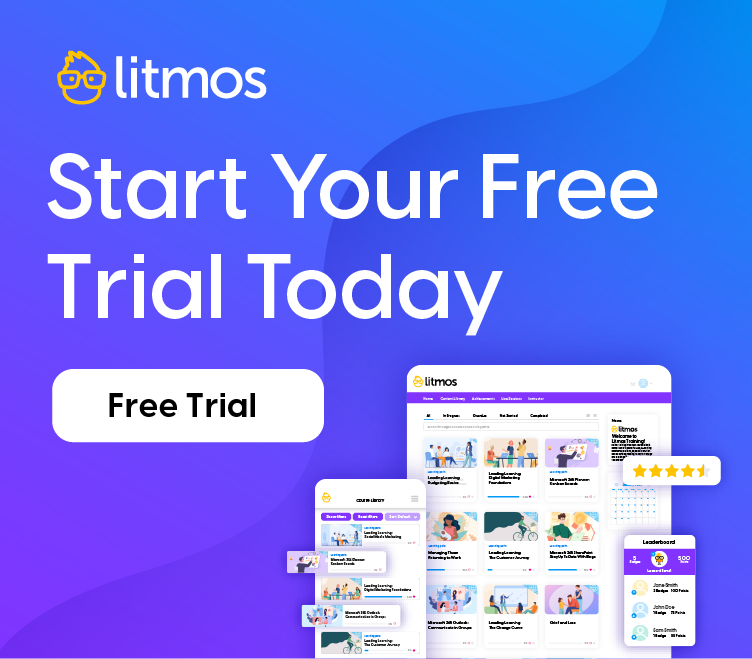The 9 Key Components of an eLearning Template
Does creating your own eLearning content cause you to procrastinate for days or even worse, cower in fear?
Well, fear not! Litmos now provides embedded AI tools within our cntent authoring tools, along with our ready-made eLearning templates that allow for rapid eLearning development. Read on to see how you can create you own eLearning templates using Litmos Content Authoring tool, and how Litmos AI content authoring features are making course development easier than ever.
How to Create eLearning Templates
Templates are valuable, time-saving tools that allow eLearning professionals to develop engaging and aesthetically pleasing eLearning courses. Best of all, you don’t necessarily need graphic design or coding experience, as the eLearning template comes complete with pre-built layouts. In the Litmos Content Authoring tool, we have six, for example.
Of course, tech-savvy Instructional designers can create eLearning templates of their own, but if that’s not you, totally fine. You can still cover all (or at least most) of your bases with the following tips.
The key is choosing an eLearning template that has the essential components for enough versatility and functionality that they’re useful over and over.
Here are the core elements that belong in your eLearning template:
- Introduction The first page of your eLearning course should be a brief introduction that gives online learners a glimpse of what they can expect. This section addresses a foundational element of the learning experience, answering the most important learner question: “What’s in it for me?” If learners don’t see value in your content, you’ll lose them at hello. Also, as is the case with all pages in your eLearning template, it should be customized to reflect the tone, subject matter, and audience for every eLearning course that you design.
- Instructions Set learners off on a clear path of what’s expected via detailed instructions that state how the eLearning platform works and how to progress through the course, even if they’re not tech-savvy. As a general rule, your instructions page will be the same for all of your eLearning courses, especially if you are using the same navigation styles.
- Goals and Objectives This section of the eLearning template is devoted to the primary eLearning goals, objectives, and benefits of the course. Make sure you create a different section for each, and that you leave plenty of room for bullet-pointed lists. Big blocks of text that fail to highlight key takeaways and benefits will leave people feeling lost and unclear what to do and why.
- Text and Image Blocks This aspect of your eLearning template differs, depending on the nature of your subject matter and the amount of information you have to cover. As a general rule, you should leave a sufficient amount of white space around the empty text blocks, and try to place the image blocks on the right-hand side of the page. This is because online learners will be scanning the screen from left to right, and you want them to focus on the text before they move on to the supporting images and graphics.
- eLearning Games, Online Scenarios, and Other Activities In addition to text/image screens you can also create specific sections for eLearning games, simulations, and any other eLearning activities that will make your course more interactive and engaging. Keep in mind that most multi-media elements will require a few pages. So, err on the side of caution and overestimate the number of screens you’ll need for each eLearning activity.
- Assessments The golden rule is to test early and often. So, leave room in your eLearning course template for periodic assessments. If you’re opting for more interactive tests, such as task-based online scenarios, ensure that there is enough space to accommodate the multi-page assessments. If possible, determine which assessment methods you’ll be using in advance, so that you can create a testing template that saves time later. For example, if you typically include multiple-choice or essay-based exams in your eLearning courses, you can create a basic structure and then simply plug in the information for each course after that.
- Recap and Review This is the section devoted to summarizing the key ideas and reviewing the benefits, applications, and take-aways for the eLearning course. Much like the objectives and goals section of your eLearning template, it’s wise to use bullet-point lists whenever possible so that your online learners don’t have to search through a block of text.
- Exit Recommendations or Instructions Designate at least one page at the end of your eLearning course for exit recommendations, suggestions, and further instructions. You can use this space to offer your online learners links to additional just-in-time resources or explain what they need to do next to receive their certificate after completion of the course.
- Placeholders Placeholders are empty template pages that allow you to add eLearning content, assessments, and eLearning activities after you’ve already designed the layout. This saves you the time and trouble of having to redo your entire eLearning template if you need to integrate additional ideas, concepts, or eLearning exercises later. As you do the final revisions for your eLearning course, you can jot down notes about how you could potentially use the placeholders, or simply delete them from the course design if they are unnecessary.
Boosting Productivity with Litmos AI Content Author
Creating high-quality eLearning content just got a whole lot easier with the Litmos AI Content Author. This innovative tool empowers instructors to generate comprehensive course outlines, clear learning objectives, and engaging course content using simple natural language prompts. The AI Content Author streamlines the content creation process, saving time and effort while maintaining quality.
One of the standout features of Litmos AI Content Author is its Prompt Strength Check. This feature assesses the prompts as you write them, providing feedback on how to improve them for better output. This ensures that you get the most relevant and effective content for your eLearning courses.
By leveraging Litmos AI Content Author, instructional designers and subject matter experts can focus on refining and customizing the generated content, rather than spending hours developing it from scratch. This not only accelerates the development process but also enhances the overall quality and consistency of the eLearning content.
If you want to create consistently high-quality learning experiences with a cohesive look and feel, you can’t skip these key elements when building an eLearning template. Litmos Content Authoring tool makes designing templates easy, with drag-and-drop features and customizable options that help everyone — from novices, to experienced instructional designers — create professional-looking eLearning content.
With Litmos, your team can create dynamic, mobile-responsive and visually appealing SCORM content within the LMS. Sign up for a live demo to see for yourself!




